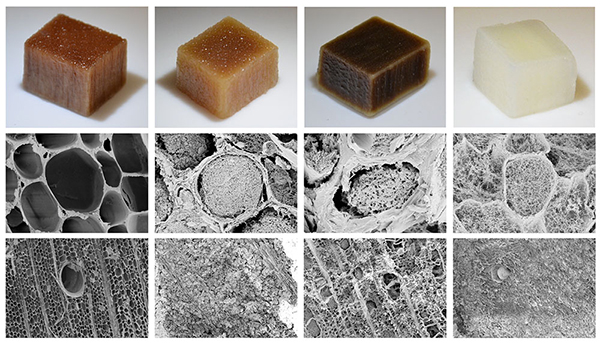At a time when energy is an issue affecting many millions of people worldwide, scientists at KTH have managed to harvest electricity by passing water through refined wood. Their work has recently been published in the journal Advanced Functional Materials.
What happens if wood is put into water, and the water then evaporates like in nature? Transpiration – this process of water movement through a plant is constantly occurring in nature. The process also produces small amounts of electricity, known as bioelectricity.
Nanoengineering improves the wood’s properties
Researchers at KTH have focused in on this. In order to increase the amount of electricity that can be harvested, the scientists have used nanoengineering to improve the properties of the wood. This is because electricity generation in wood is influenced by several factors such as area, porosity (density), surface charge,how readily water can pass through the material, and the water solution itself.
"We have compared the porous structure in regular wood with the material we have improved with regard to surface, porosity, surface charge and water transportation. We have measured electricity generation that’s ten times higher than natural wood," says Yuanyuan Li, Associate Professor at the Division of Biocomposites at KTH.
 On the far left, natural wood is seen. The three pieces of wood on the right have undergone different types of treatment that give a higher surface area and smaller pores, which provide rapid water transport through the material. Photo: Jonas Garemark.
On the far left, natural wood is seen. The three pieces of wood on the right have undergone different types of treatment that give a higher surface area and smaller pores, which provide rapid water transport through the material. Photo: Jonas Garemark.
Ten times higher
 Yuanyuan Li, associate professor in the biocomposites department at KTH.She adds that further tuning the pH difference between wood and water, due to an ion concentration gradient, achieves a potential of up to one volt and a remarkable power output of 1.35 microwatts per square centimetre.
Yuanyuan Li, associate professor in the biocomposites department at KTH.She adds that further tuning the pH difference between wood and water, due to an ion concentration gradient, achieves a potential of up to one volt and a remarkable power output of 1.35 microwatts per square centimetre.
"At the moment we can run small devices such as an LED lamp or a calculator. If we wanted to power a laptop, we would need about one square metre of wood about one centimetre thick, and about two litres of water. For a normal household we’d need far more than that, so more research is needed."
Li says that to date, the wood has managed to deliver high voltage for about 2–3 hours, before it starts waning. According to the researchers, so far the wood has managed ten cycles with water, without a decline in the material’s performance.
"The great advantage of this technology is that the wood can readily be used for other purposes once it’s depleted as an energy source, such as transparent paper, wood-based foam and different biocomposites."
Source: KTH













